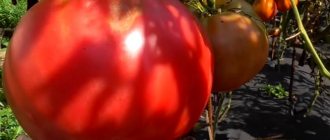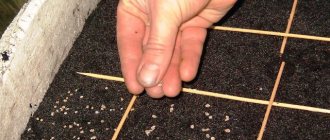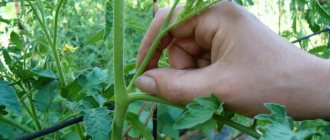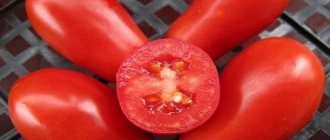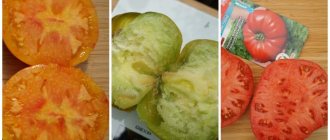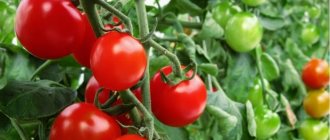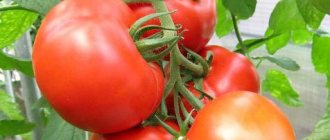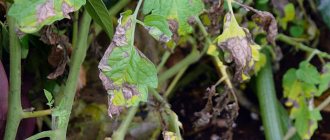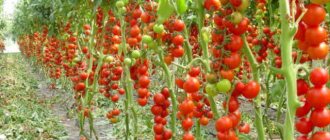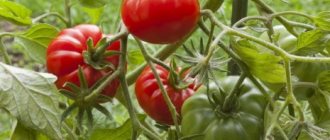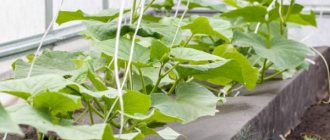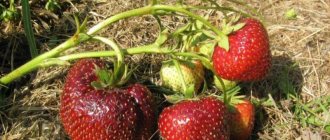The best early variety - White filling 241
This is an early ripening variety of tomatoes with a good yield - 8 kg per square meter. The average fruit weight reaches 100 grams. White filling can grow both in greenhouse conditions and in the open air.
Gardeners love White filling for its unpretentiousness to weather conditions (it produces crops even in cold summers), excellent taste and resistance to heat. The variety does not require special care and is immune to macrosporiosis. Another common “tomato” disease - late blight - White filling does not have time to get sick due to early ripening.
Tomatoes resistant to cold and viruses
In temperate climates, where summers are often rainy and cool, spring is quite late, and autumn, on the contrary, is early, the durability of tomatoes is very important. Domestic gardeners prefer hardened varieties to pampered “exotics”. Such tomatoes can be grown not only in the south of the country, but also in the Urals or Siberia.
Usually, varietal tomatoes of domestic selection turn out to be “stronger” than foreign hybrids. In addition, such tomatoes contain much more nutrients and vitamins and have a more pronounced taste. Therefore, for many, these are the best varieties of tomatoes for open ground.
"Marmande"
The seedlings of this tomato can be transferred to the beds already in early May, which is two weeks earlier than usual. This allows you to get very early harvests, and also avoid tomato fruiting in too wet and cool August.
The weight of the fruit reaches 250 grams, which is rare for a representative of this group.
The Marmande tomato resists not only fungal and viral diseases, it does not attract pests and insects.
"Stellate sturgeon"
A tomato selected in Holland, but acclimatized to the weather conditions of Russia. The fruits are very large - sometimes more than 450 grams. The tomato peel is dense and the flesh is tender. The fruits are well stored and can withstand transportation.
Although the height of the bush reaches 140 cm, the powerful stem does not need to be tied up. Also, the plant does not need pinching.
"Roma"
This variety can be classified into two groups: it produces high yields and is considered the most resistant to fungal pathogens. The growing season is 120 days, and in the last two weeks of this period the plant can withstand significant temperature drops, even frost.
120-centimeter bushes require pinching. The fruits on them grow of medium size - approximately 140 grams in weight.
Review of tomato "Roma"
Stepanova I.A., 54 years old, Novosibirsk
I read on the Internet that the “Roma” variety is not very suitable for growing in Russia; it is more popular in the USA. But I decided to try it anyway – I was attracted by the tomato’s resistance to cold weather (we live in Siberia). The variety met all my hopes, it gave a good harvest, the tomatoes were elastic and beautiful. Of all the bushes (about 40), only two disappeared, and even then during the period of planting seedlings in the ground. Tomatoes are perfect for canning and making our family’s favorite tomato paste. I recommend the Roma tomato to everyone, especially those who live in the northern regions.
The best mid-season variety - Favorite holiday
It belongs to the medium-sized varieties of tomatoes, and its fruits cannot be called small. On average, they grow 300-500 grams, and weigh up to 1.3 kg. From one square meter, ideally, you can harvest 7 kg of pink, juicy tomatoes with moderately thin skin. Ripening period is 105-110 days.
The favorite holiday requires tying and pinching, and is also very sensitive to feeding. Otherwise, it is unpretentious in care and is highly resistant to nightshade diseases.
Varieties for individual regions
For each region there are new tomatoes zoned for the local climate. Accurate information about the tested varieties is available in the State Register. Plants adapted to the weather conditions of the region reach their full potential.
For the Moscow region
The rating of tomatoes opens with the Pink Tulip variety. A variety of amateur selection, mid-season, tall (1.5−2 m), indeterminate type. There are 4-6 ovaries in the hand. The pepper-shaped fruits are shaped like a tulip bud. There are few seeds in the pulp; it has a mild, pleasant taste. Weight 200−400 g, yield 3 kg per bush.
This season you should pay attention to interesting varieties:
- Legend Tarasenko. There are few leaves on the bushes, but there are many huge clusters with beautiful rounded fruits. Tomatoes with a spout will ripen throughout the season. They are suitable for all types of processing.
- Bendrik's cream. A very productive hybrid - 8 kg per bush. Cream weighing 80−100 g comes in 2 colors: yellow, red. The bushes have one stem and are grown in the garden and greenhouse. Up to 25 ovaries are formed in the brush.
- Psamatha. Bred in Canada, very productive, mid-season. Bushes of indeterminate type have 2-3 stems. The tomatoes are brown-purple, weighing 40-50 g. About 3 kg of them are harvested from one plant.
- Bloody butcher. The variety was bred in the Netherlands for cultivation in greenhouses. Plant of indeterminate type (2 m). Fruits weighing 50−90 g, red. In the Moscow region, the first tomatoes ripen at the end of June.
- Baker's grandmother. This tomato is for greenhouses. Bushes 1.5−1.8 m high have 1-2 stems. Ripe fruits are red in color, round in shape, weighing 300-700 g and ripen in 100 days. One plant produces 3 kg of fruit.
- Barrel. An early ripening hybrid ripens in 100 days. Each stem produces 5 clusters with 6 ovaries. Bushes of indeterminate type, powerful. There are many stepchildren. Advantages: drought and heat resistance.
Not all gardeners receive the harvest stated on the package. This is not due to the quality of the seeds, but due to violations of agricultural practices and bad weather.
For the middle band
At the end of February, seeds are sown for greenhouses, in March - for open ground. The ranking of varieties is based on the results of past seasons:
- Sea Horse. Grown for harvesting in vegetable gardens and greenhouses. Bushes 120−180 cm high love the sun. The fruits have an original shape, they look like light bulbs. When ripe, they are bright red, weigh 100−150 g. Productivity is 5 kg per bush.
- Mascot. Productivity does not depend on the weather. The bushes are compact, determinate type, 50 cm high. The fruits are not large (20 g), red.
- June. A variety for busy gardeners. The bushes do not need to be pinched; they do not grow higher than 50 cm. Early harvest (100−110 days) - 8 kg/m². The tomatoes are not large - up to 60 g, classic red, round.
- Golden Canary. Interesting yellow fruits with a spout weigh 70 g. They are grown for canning.
- Red butter heart. The shape of the fruit is heart-shaped, beautiful, the weight of outstanding specimens is up to 1 kg. The variety is productive - 5 kg per plant.
- Figs (red, pink, yellow). New productive variety – 25 kg/m². Ripening period is 100−110 days.
- Flyashen. German selection. Small (40−70 g) fruits are collected in clusters. They are red and finger-shaped. They are dried, canned, and frozen.
Comment! Flyashen is a variety, so you can use your seeds for the next season.
For the Urals and Siberia
For the 2021 season, we can recommend fruitful varieties whose fruits will have time to ripen before the August cold snap:
- Minusinsk glasses;
- Altai orange;
- Cornabel;
- Bison (series);
- Budenovka;
- Dragon tooth.
The best late-ripening variety is De Barao
One of the most popular tomato varieties in Russia is suitable for both greenhouses and open ground. It grows up to 2.5 meters in height, and needs tying to a support and pinching, as well as active fertilizer. According to reviews, it is productive, tasty and not prone to disease. And in the greenhouse it bears fruit until the first frost.
As a reward for your efforts, De Barao will reward you with fruits of high taste. They do not crack during heat treatment, tolerate transportation well and are suitable not only for salads, but also for making juices, as well as for canning.
Early ripe tomatoes
Tomato seeds "Pervoklaska"
This variety is considered one of the most versatile, and fruit ripening occurs approximately 90-105 days after sprouting. It is perfect for open spaces, since the maximum height of the bush does not exceed 100 cm; it needs tying, but this is not necessary, since the fruits ripen well on the ground surface. The bush should be formed into three stems, as this ensures maximum yield. From one bush you can collect about 6 kg, and the fruits lie well and withstand transportation. In addition, this type of tomatoes will feel excellent both in open ground and in a greenhouse. The first stalk is formed approximately on the 6-7th leaf.
The average weight of the fruit is about 250-300 grams. The ribbing is low, the shape is flat-round, painted bright pink. Tomatoes of this variety have thin and slightly transparent skin, slightly translucent. The taste is pronounced tomato. Well suited for direct consumption, canning, preparing ketchups, juices, pastes and other tomato products. In terms of chemical composition, this variety has many vitamins, sugars, and lycopene, which will support human immunity.
More: Top 5 best goat milk infant formulas
Advantages:
- High germination rates;
- Pleasant to the taste;
- Compliance with the labels on the packaging and real indicators.
Flaws:
- The lower leaves are quite large, which is why ripening may slow down by one to two weeks.
Tomato seeds "Pervoklaska"
Tomato seeds "Red Rooster"
Perfectly suited for most climatic conditions of our country, it will feel good both when grown indoors and in open ground. This variety ripens earlier than all others - for this it only needs about 85 days under optimal weather conditions. If the weather is a little cooler, then this period may be delayed by about 10-15 days. When seedlings are planted in open ground at the age of approximately 60-65 days, this allows the first fruits to be harvested after 30-35 days. The maximum height of the bush is 80 cm, so it does not require garter. In addition, it does not need tying. The best yield is ensured if there are no more than three stems on the bush.
The fruits are quite large - their average weight is about 250-400 grams; if you care for the plants well enough, you can achieve heavier tomatoes. The color is bright red, there is slight ribbing in the area of the stalk. The taste is sweet, there is a slight sourness. Tomatoes are universal - they can be eaten fresh, pickled, pickled, made into juices, pastes, and so on. It tolerates transportation quite well.
Advantages:
- The variety is unpretentious to weather conditions;
- Large fruits;
- The harvest is large, about 5 kg of fruit can be collected from one bush.
Flaws:
- A hybrid variety, you won’t be able to get the seeds yourself.
Tomato seeds "Red Rooster"
Tomato seeds “My love F1”
The height of this variety is about 50-80 cm, in greenhouse conditions and in the south of the country it can grow up to 120 cm. The average fruit ripening period is about 90-100 days, well suited for both greenhouses and open ground. This variety does not have very many leaves, the fruits do not become cracked during ripening, and the plants are well resistant to diseases and pests, including aphids. The immunity of this variety is one of the highest among all the best tomatoes of 2021 presented in our review. The color of tomatoes is red or bright red, they are round in shape, slightly elongated. The pulp is sugary, the taste is typical tomato, slightly sweet.
Weighing approximately 150-200 grams, all fruits are the same size, which can significantly increase their commercial value. There are four seed chambers, dry matter content is no more than 5%. Tomatoes withstand transportation remarkably well and can be stored for a long time in a cool place. The fruits look ideal as canned products, but they are also well suited for fresh consumption. They contain a significant amount of vitamins and sugars, making them very beneficial for health.
Advantages:
- High germination rate – can reach about 97%;
- Great taste;
- Fast maturation.
Flaws:
- In a strong wind, despite their short height, they can either bend significantly or even break.
Tomato seeds “My love F1”
The best elongated variety is Gulliver
If you are looking for elongated tomatoes that are resistant to heat and major nightshade diseases, and have excellent taste, then Gulliver is the best option. This variety is suitable for preparing salads, tomato products and can be used for preparations. Withstands long-term transportation and storage for 20-30 days.
Although this variety is recommended for cultivation in the Central Black Earth region, it is successfully bred in all regions of Russia. Even in Siberia, only there it is advisable to grow it indoors.
Gulliver is an early-ripening variety; on average, 100 days pass from the moment of planting to the full ripening of the fruit. From one square meter (on which there are 3-4 seedlings) up to 6 kg of fleshy, sweet fruits are collected.
These tomatoes do not need pinching, but they do need staking, otherwise they may not be able to withstand the weight of their own fruits.
Large-fruited tomatoes
Not everyone cares about the yield or durability of tomatoes. Although large-fruited or unusual tomatoes are typically grown in protected greenhouses, odd-sized tomatoes can also be grown in garden beds.
"Pudovik"
The variety is considered the largest-fruited of those intended for cultivation in Russia. The weight of one tomato can reach a maximum of 1000 grams. At the same time, about ten tomatoes are formed on the bush at the same time. The yield of the variety reaches 5-6 kg per plant.
It is clear that the Pudovik tomato bushes themselves cannot be small - the plant is indeterminate, reaching a height of 150 cm. The tomato needs good feeding, this not only stimulates the growth of the plant and the development of the ovaries, but also increases its immunity, which is important for the fight against viruses and bacteria.
The technical maturity of tomatoes occurs on the 115th day after planting in the soil (mid-early tomato), so they can be grown in any region, even in Siberia.
"Tolstoy"
The variety has been grown in Russia for more than a quarter of a century, and does not lose its popularity. The hybrid is considered high-yielding, since about 12 kg of tomatoes can be harvested from each square meter.
The average weight of the fruit is 250 grams, the tomatoes have good taste and rich aroma. The height of the bushes reaches 150 cm, the plants are spreading, but do not require pinching. The Tolstoy tomato is not afraid of most “tomato” diseases, such as powdery mildew or fusarium, for example.
"Bull's Heart"
An equally famous tomato, which every gardener planted on his plot at least once. The bushes reach a height of 130 cm, have powerful stems and side shoots.
A special feature of the variety is that the fruits from the first flowers are the largest, their weight can range from 350 to 900 grams. And the next tomatoes will be much smaller - about 150 grams.
The shape of the tomato is unusual, it looks like a heart. The fruit is pinkish in color. The taste is excellent - the tomato is fleshy, juicy and very sweet. Such fruits are mainly used for fresh consumption and for making salads.
Review of tomato “Bull's Heart”
Alina Sergeevna, 48 years old, Khabarovsk
I am a fan of large-fruited tomatoes. After all, only such fruits can you eat to your heart’s content over the summer! In addition, they contain a lot of useful minerals and vitamins, and they are consumed fresh, which significantly increases the dose of “benefits”. In my garden beds I always grow “Bull’s Heart” and a couple of other varieties for pickling. This variety has never failed. True, like all large-fruited tomatoes, it requires special attention: fertilizer at least 6 times per season, good watering, assistance in pollination, tying to trellises or supports. But the appearance and taste of a ripe tomato will not leave anyone indifferent!
The best variety for pickling and canning - Pickling miracle
The very name of this variety speaks about why it was bred by Russian breeders.
The fruits of the Pickling Miracle grow on low bushes (45-50 cm), so they do not require supports or pinching. Thanks to its compact size, you can plant many bushes in one area.
This variety feels equally good both in protected ground and in a windswept area. And from the appearance of the first shoots to the time of harvest, an average of 80-100 days pass.
The fruits of the Pickling Miracle are small (up to 90 grams), convenient for canning and transportation, and keep their shape well in a jar. They are dense, juicy, but not too sweet.
Low-growing tomatoes for greenhouses and open ground
Gardeners deservedly love low-growing species, as they:
- often early ripening, ripen faster
- less need for stepsoning
- the fruits ripen almost simultaneously
- Due to rapid development, late blight is less likely to occur.
Suitable for greenhouses:
- “Alaska” - height about 50 cm, early, sweet tomatoes, however, suitable only for salads (cannot be preserved)
- “Riddle” - almost half a meter high, high-yielding, disease-resistant, the tomatoes themselves are red, spherical, and keep their shape well.
It is worth planting in open ground:
- “Watercolor” - height no more than 50 cm, elongated fruits with thick skin, good for harvesting and salads, the variety is not prone to diseases
- “Golden Stream” - bushes 60-80 cm, but productive, elongated fruits, golden or yellow in color
- “Banana legs” - height about 75 cm, ripening quickly, disease resistance, fruits collected in tassels, orange-yellow, weighing less than 75 g, with an unusual citrus taste
- “Kalinka-Malinka” is an unpretentious mid-season super-determinate tomato less than 25 cm high, suitable for beds, greenhouses, film shelters, high yield, universal use, tasty, ripen at the same time, can be stored for a long time, although small - about 50 g
- “Snow Queen” - early, determinate, the bush grows 30-45 cm, the fruits are flattened, red, weighing about 120 g, do not crack, universal use, the plant tolerates drought and cold weather well, rarely gets sick
Best Original Variety - Amethyst Jewel
This Signor Tomato is distinguished by its fruits of extraordinary beauty. And, like many handsome men, he is very capricious, cannot stand cold and heat. The optimal temperature for growing Amethyst Jewel is 25°C.
This variety is a mid-season variety; in a greenhouse the bushes grow up to 1.2 meters in length, and the fruit weighs 150-300 grams. The taste of Amethyst Jewel is sweet-salty, meaty and delicious.
Tomatoes resistant to late blight and other diseases
Tomatoes are often affected by late blight, and other diseases are also present. In order to protect the future harvest, to save yourself from the hassle and frustration of losing a planting, you should give preference to tomatoes that are initially resistant to these diseases. The most popular of them:
- “Azhur F1” is a mid-early variety for growing in garden beds, high-yielding, tolerates late blight and many other diseases, height up to 80 cm, grown tomatoes are round, red, weighing up to 250 grams
- “Bohemia” is a determinate, medium-sized hybrid of universal use, large tomatoes, collected in clusters, yield per bush up to 6 kg
- “Blitz” is a determinate variety, suitable for greenhouses, open ground, mid-early, fruits up to 100 grams, resistant to late blight, tobacco mosaic, septoria, fusirium, necrosis
- “Oak” is a greenhouse determinate, bush height up to 62 cm, weighing about 100 grams, ripen almost simultaneously, high yield
- “Khokhloma” is an indeterminate mid-season variety that grows up to 2 meters, is resistant to late blight, fusarium, “mosaic”, cladosporiosis, tomatoes are red, elongated, cylindrical, weighing no more than 150 g, transported and stored well, some consider these tomatoes to be too juicy, dense
The best variety for greenhouses – Miracle of the Earth
This relatively new tomato variety was bred by Russian breeders and entered into the State Register of the Russian Federation in 2006. Its characteristic features:
- Dense and juicy deep pink fruits (average 500 g),
- high yield - up to 20 kg per square meter in the southern regions and 12-15 kg - in the risky farming zone,
- long fruiting,
- good immunity to many diseases of nightshade crops,
- the fruits do not crack even during days of rain, and retain their quality for up to 2 weeks,
- high taste qualities of fruits, which are suitable for salads, juices and various preparations.
The ripening of Miracle of the Earth tomatoes occurs in 100-125 days. Since the stems of this variety can reach up to 180 cm in length, and the fruits are very large, the plant definitely requires reliable support and garter.
Please note : since Miracle of the Earth tomatoes are very popular, unscrupulous sellers take advantage of this. Therefore, buy seeds only from specialized online stores with a good reputation.
Tomatoes: selecting varieties and growing seedlings
I understand that this year the topic is somewhat late... But it’s never too late to exchange opinions and experiences, and every gardener probably has his favorite varieties of tomatoes, criteria for their selection and his own tricks, secrets of good seedlings. So let's discuss...
How to choose varieties
To make a successful choice, you will need to delve a little deeper into the classification.
For us, two characteristics are primarily important: the time of ripening (growing season) and the type of growth. The first one is quite simple: tomatoes are early-ripening, mid-ripening and late-ripening. The second sign is more difficult to understand: for example, I am still confused by the terms “determinant” and “indeterminate”; the concepts of “short” and “tall” are closer to me. But on packets of seeds they usually use these terms to describe them, so we will stick to tradition. The significant difference between these varieties is that indeterminate, or tall, tomatoes do not stop growing, that is, they grow like a vine - 2 meters in height or more. When a flower cluster appears on the main stem, it is replaced by the stepson closest to the top, which, in turn, after the formation of buds will be replaced by a shoot that has already grown from its top - and so on.
Determinate, or low-growing tomatoes form relatively short bushes with limited growth. Their stepsons, as a rule, grow only in the lower part of the trunk. On each branch (depending on the variety) 2-6 flower clusters are formed, after which the growth of the shoot stops. The result is not a vine, like tall tomatoes, but a bush.
Tomato seeds of various varieties are presented in our catalog in a huge assortment - after all, offers from many large garden online stores are collected here. Choose tomato varieties for your garden .
Tomato Fantasy 22 RUR
Russian Vegetable Garden
Tomato Wonder of the World 17 RUR
Russian Vegetable Garden
Tomato Honey pink 28 RUR
Russian Vegetable Garden
Red bell tomato 14 RUR
Russian Vegetable Garden
The first thing you need to determine when choosing varieties is where the tomatoes will grow. In the not particularly favorable conditions of the Middle Zone and the North-West, this crop is usually grown in greenhouses. But you can also grow tomatoes in open ground - subject to a number of conditions, of which the variety is perhaps the most important.
So: for open ground, low-growing (determinate and super-determinate) varieties are preferable, better than early ripening ones. Mid-season crops with a good summer will give an excellent harvest, but there is a high probability that in August a significant part of it will be destroyed by late blight. It’s not for nothing that we have a “risky farming zone” - you decide whether it’s worth the risk).
Tall (indeterminate) varieties and hybrids are usually grown in greenhouses. Here you can safely plant not only early, but also mid-season and even late-ripening tomatoes.
It is also worth paying attention to the purpose of the variety (there are those intended for canning; there are exclusively salad varieties; for fresh consumption, these are often large-fruited varieties; there are those for universal use).
If you want it to be beautiful, or just love everything unusual, choose by color - in addition to yellow and red tomatoes, breeders will offer other options (for example, green Emerald Apple , purple-black Black Elephant or striped Tiger ).
Yes, there are also cluster tomatoes (mostly hybrids), characterized by the fact that they have 6-7 (rarely more) identical tomatoes ripening on one cluster at the same time. They can be cut and stored together with the brush ( Roksolana F1, Samara F1, Sprut F1 and others). Today, many people are interested in growing vegetables at home and on loggias and balconies. A home garden is a pleasure for a summer resident who yearns for the land in winter)). For growing in containers, choose the most compact plants that are specially adapted for such conditions (a classic example is the Balcony Miracle ).
Finally, out of all the abundance, give preference to zoned varieties (this is especially important for open ground and useful for greenhouses). Such varieties are better adapted to the local climate and, accordingly, will better reveal their inherent properties. A little about the varieties themselves. Of course, just as an example - there are too many of them to talk about them all in detail.
Early and mid-early determinate varieties Sanka - ultra-early ripening (75-85 days), forms few stepsons, and is consistently productive. For open ground; universal purpose.
Far North - a standard plant for open ground and film shelters; cold-resistant.
Siberian early ripening (98-108 days), high-yielding variety for universal use.
And also: Moskvich, Yamal 200, Yablonka Rossii, Dar Zavolzhye, Lyana and others.
Early and mid-season indeterminate varieties Zlato Skifov (105-110 days) for film shelters and greenhouses. Requires pinching and gartering. The fruits are orange-yellow and are intended for fresh consumption and for making juices.
Ogorodnik is a mid-season large-fruited variety for film greenhouses.
Black prince (102-110 days), up to 2.5 m high. Large fleshy fruits, color from dark burgundy to brown. A variety for universal use.
Late ripening indeterminate varieties Giraffe (140-160 days), plants up to 1.8 m or more in height. Harvest; the fruits are well stored. Designed for canning.
Bull's heart is a medium-late variety (125-132 days) for film greenhouses and open ground. Large fruits mainly for salad purposes.
series (De Barao Golden, Pink, etc.) are medium-late (120-125 days) vigorous varieties with different fruit colors. Popular productive varieties for universal use.
Ads by
Growing tomato seedlings
A “sick” annual question: when to sow tomatoes for seedlings? To determine the sowing date, you will have to do a little arithmetic.
- We take the approximate planting date (it depends on the region; on where you will plant: in a greenhouse, in a greenhouse or in the ground; on the forecast for spring: whether to expect it early or late).
- We subtract from this date the optimal age of seedlings: 70 days for late, 55-60 for mid-season varieties and 40-50 days for early tomatoes.
- We subtract another 5-6 days (the average time for seed germination at temperatures from +24 to +26 degrees) and get the sowing date.
There is no need to rush: overgrown seedlings take root worse.
You can sow dry seeds, or you can pre-soak them. An ash solution speeds up germination well (stir 2 tablespoons of ash in a liter of hot water and leave for two days), but in urban conditions it is difficult to find ash, so various preparations are used. I like, for example, Fitosporin-M - it both improves germination and provides protection against diseases, that is, this treatment replaces the disinfection of seeds in a solution of potassium permanganate.
It is convenient to sow in small boxes or containers, for example, in food-grade plastic containers. Tomatoes benefit from picking, so it is better not to abandon this procedure. Tomato seedlings germinate 15-20 days after emergence. When planting, they are buried down to the cotyledon leaves and shaded from the sun in a window for two days until the sprouts recover from transplantation.
Caring for tomato seedlings consists of watering and maintaining the temperature at +20...+25 degrees during the day and +18 degrees at night. In this case, of course, you need good lighting - if natural lighting is not enough at first, then the seedlings will have to be illuminated with fluorescent lamps. Tomatoes need a lot of light.
But it’s better to water without excessive zeal: excess moisture can cause blackleg disease. Wait until the soil dries. You shouldn’t overuse fertilizing either; As a rule, purchased soils contain enough nutrients, and excess of them will only harm the plant. Therefore, if the seedlings are healthy, the stem is strong, the leaves are strong, dark green in color - it is better not to feed the plant, it has enough of everything.
One or two weeks before planting the seedlings in the ground, they begin to harden them, gradually accustoming them to the conditions in which they will continue to be. Just don’t start “health treatments” until the outside temperature has risen above +10 degrees. It is important that it is necessary to accustom it not only to street air, but also to the sun - this is also stress for the plant.
What special techniques or tricks do you use when growing tomato seedlings? Share your secrets!
PS The photos this time are not all mine - I don’t have enough vegetable photos...
The best variety for open ground - Koenigsberg
This mid-season tomato variety produces its first fruits 100-115 days after sowing the seeds. Koenigsberg can withstand even harsh Siberian conditions and is ideal for open ground. From one square meter you can collect from 4 to 18 kg of fruits weighing 150-300 grams.
Koenigsberg reaches an impressive 2 meters in height, and requires mandatory gartering and shaping.
There are different types of Koenigsberg: red, gold (popularly called “Siberian apricot”), pink, striped, heart-shaped. All of them are distinguished by their bright aroma, pleasant taste and increased resistance to most diseases of nightshade crops. This variety is also not afraid of drought and heavy rains.
The most delicious and sweet tomatoes
The tomato contains six components that affect its taste:
- sugar,
- carotenoids,
- fatty acid,
- amino acids,
- polyphenols,
- organic acids.
Tomatoes with low sugar content and high acid content have a sour taste. Tomatoes with high levels of sugar, acid and carotenoids are considered the most delicious.
Expert opinion
Stanislav Pavlovich
Gardener with 17 years of experience and our expert
Ask a Question
Note: you can visually determine the taste characteristics of the fruit by the intensity of the color - the brighter the tomato, the better its taste.
Roma
Heat-loving tomato crop of determinate type with a long fruiting period. After planting in the garden, the ripening period of tomatoes lasts from 105 to 125 days. Stem height is within 35-60 cm. A high-yielding variety, from 1 m2 you can get up to 10 kg of tomatoes weighing up to 80 g. Tomatoes are rich red in color, plum-shaped, dense, fleshy, have an excellent taste, are suitable for long-term storage, excellent endure transportation.
Siberian trump card
A low-growing crop with a spreading shape, a stem height of up to 80 cm. Ripening time is 110 days. The fruits are red-crimson in color, flattened, rounded in shape with slightly pronounced ribbing, weighing up to 700 g. The advantage of this large-fruited variety is its consistently high yield; you can get 5-7.5 kg per bush. The variety is resistant to weather collisions and diseases.
The Tsar Bell
An early-ripening large-fruited tomato variety with high yield, it belongs to the category of semi-determinate crops, the maximum height of the stem is 100 cm. The weight of ripened tomatoes reaches 200-800 g, they are red in color, with fleshy pulp and a sweet taste, smooth, heart-shaped. The average yield is 8.6 kg per 1 m2, with proper care it can be up to 18 kg.
Sweet heart F1
Medium-sized crop of hybrid origin, with early fruiting. The growing season is from 90 to 95 days. The height of the shoots reaches 90 cm, from 4 to 6 berries are tied on the brushes. Productivity is up to 10 kg per 1 m2 of sown area. Tomatoes are round in shape with a spout at the end, deep red in color, weighing up to 150 g.
Pink honey
A mid-early tomato variety with large pink fruits. The growing season ranges from 110 to 115 days. In open sown areas, the height of the stems reaches 1 m or more.
The fruits are heart-shaped, the tomato pulp is sugary and tastes very sweet. The average weight of the fruit is from 600 to 800 g, the weight of the berries on the lower first clusters can reach 1.5 kg. The fertility of the variety is up to 6 kg per bush.
Appetizing
Tomato is a determinate type vegetable crop with an average growing season. The maximum height of the bush when sown in open ground is up to 90 cm, yield is up to 5 kg per bush. Ripe fruits are wine-red in color, juicy and dense, weighing up to 500 g. Initially, breeders developed this variety as a salad crop, but due to its excellent taste properties they began to actively use it for making sauces.
The best variety for growing on the balcony is Florida Petit
Do you want to start a mini-tomato garden on your windowsill or balcony? Florida Petite is ideal for this task.
This is a low-growing (20-40 cm) and early ripening variety that does not require special care and tolerates both temperature changes and low light levels. From the moment of germination to the appearance of fruit, an average of 85-95 days pass.
The tomatoes themselves are small but sweet because they contain large amounts of sugar and lycopene. From one Florida Petit bush you can collect up to 500-600 g of fruit over the summer.
How to grow tomatoes outdoors
The process of growing tomatoes in garden beds is not much different from the greenhouse method. To get a good harvest, tomatoes need to be looked after regularly - this crop loves the sun, timely watering, and loose soil.
A summer resident or gardener needs to complete the following steps:
- The soil for tomatoes should be prepared in the fall. The soil on the site is dug up and fertilizers are added to it.
- In the spring, the soil must be disinfected by treating it with manganese or another antibacterial solution.
- Tomato seeds are pre-sown for seedlings. This is done at the end of February or beginning of March.
- Strong seedlings (about 30 cm high) can be planted in a watered garden bed. As a rule, this is done in mid-May, when the air temperature at night will not drop below zero. The Siberian climate is more severe, so tomatoes are planted in the ground here at the end of May or even at the beginning of June.
- In the first week, it is better not to water the tomato seedlings; they need to acclimatize and get stronger.
- During the entire growing season, tomatoes are fertilized 2-3 times. The main thing is not to overdo it with the application of mineral fertilizers, otherwise the tomatoes will grow instead of devoting all their strength to the ovaries.
- Watering tomatoes should be timely and regular - the soil between the bushes should not be dry and cracked.
- The soil between the rows must be fluffy - the roots need air.
- It is better to pick tomatoes when they are fully ripe. But if weather conditions do not allow, or the crop is intended for transportation or storage, you can also harvest green or brown tomatoes - they ripen well in a cool, dark place.
Important! Tomato bushes tend to produce many side shoots. To ensure a high yield, it is necessary to get rid of excess greenery - the bushes are pinched or stepsoned.
There are varieties of tomatoes that do not require pinching, since they practically do not produce side shoots.
The most productive variety – Yellow Necklace
Small and bold - that’s how you can briefly characterize this super-yielding variety of tomatoes. One cluster contains 30-40 small, but very sweet fruits, and the Yellow Necklace bears fruit until late autumn. The yield from one bush per season reaches 1.5 kg.
In addition, this variety withstands unfavorable weather conditions, be it heat or cold, is resistant to nightshade infections and retains its attractive appearance and taste for a long time. You just need to place it in a well-lit place, without shade. Otherwise, Yellow Necklace is an ideal choice for a gardener who needs a lot of tasty and healthy tomatoes. Due to their small size, these babies are difficult to assemble. But it's worth it.
High-yielding tomatoes for polycarbonate greenhouses
Determinate or tall varieties are ideal for polycarbonate shelters, as they form a single stem with a significant number of fruits. Often these tomatoes are large in size. These include:
- Ox heart - red-pink fruits weighing almost 700 grams, needs garter, frequent watering, stable temperature
- "Mikado" - large, red-pink, sugary, fleshy fruit, suitable only for greenhouses
- “Velioko Plus” is an early-ripening, high-yielding hybrid, the height of the bush is almost 1.5 m, red spherical, slightly flattened fruits weighing about 130 g are collected by kistamit, the pulp is fleshy, dense, with a pleasant taste, the skin is thin, created for greenhouses and hotbeds
- "Cardinal" - fleshy raspberry tomatoes weighing up to 800 grams, with a distinct aroma
- Abakan pink - early ripening, medium weight, 100-300 g, beautiful pink fruits
- De Barao red and yellow - yield on the 120th day, yields almost 4 kg per bush, resistant to late blight, perfectly stored and transported
From cherry to "giants"
Tomatoes differ not only in the height and power of the bushes, but also in the size of the fruit. The list of the best large-fruited tomatoes includes the following varieties:
- Bugai pink
A tall plant, up to 1.8 meters, producing large fruits weighing 800-1200 grams. An unpretentious variety of Siberian selection, tomatoes are used for salads and processing.
- Cardinal
The appearance of the tomato fruit resembles the popular and well-known variety Bull's Heart. The tomatoes are fleshy, raspberry in color and have excellent taste. Weight – 400-500 grams. Good in salads, suitable for making sauces and juice. In the State Register of Varieties - since 1988.
- Nonna M
A variant of Bull's Heart from Siberian breeders. Productive (up to 4-5 kg bush) tomato with fleshy raspberry fruits. The shape of the tomatoes is heart-shaped, weight – 600-700 grams. Ripening dates are mid-early.
- Russian size F1
The fruits of this variety differ from agro in their high taste, which is not so common in tomato hybrids.
The weight of round pink fruits is 400-500 grams, unique ones grow up to 1-1.5 kg. The tomato is medium-late, powerful, and requires intensive feeding.
Fruitful varieties of tomatoes are small-fruited cherry tomatoes, which are valued for their excellent taste and sweetness. A number of varieties are grown at home on windows or on balconies. Interesting cherry tomatoes Caprice F1, Honey Candy F1, early Strawberry cherry F1.
The best varieties of large-fruited tomatoes in a greenhouse for Siberia and the Urals
Many people love big, beautiful tomatoes - so that they can rejoice looking at such beauty and boast about it to their neighbors. Even residents of the Urals and Siberia can grow such beauties, provided they have a good greenhouse. Suitable:
- "Bersola" is a low-growing, early-ripening hybrid with large fruits, each about 150 grams
- "Titanic" is an early greenhouse hybrid with large (about 200 grams), sweet fruits, resistant to diseases
- “Velmozha” is a determinate tomato with large heart-shaped raspberry fruits weighing about 250 g, the pulp is tasty, fleshy
- “Golden Koenigsberg” is a tall greenhouse high-yielding plant, bush height 1.5-1.8 meters, fruits 200-400 g, oblong shape, beautiful yellow-golden color with juicy pulp almost without seeds, resistant to diseases, but due to its thin , the seemingly frail stem needs regular tying, the formation of a bush is also necessary, the purpose is universal
All that remains is to choose a variety that ideally suits all your requirements and, after following all the tips on sowing seedlings and caring for tomatoes, grow, harvest, and process the entire rich harvest. Good luck with your dacha work, subscribe to blog updates!
